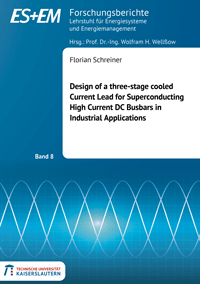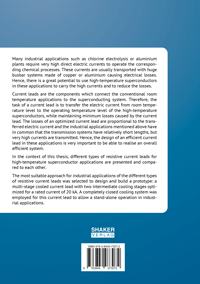
Shop : Details
Shop
Details
48,80 €ISBN 978-3-8440-7307-2Softcover160 pages87 figures236 g21 x 14,8 cmEnglishThesis
April 2020
Florian Schreiner
Design of a three-stage cooled Current Lead for Superconducting High Current DC Busbars in Industrial Applications
Many industrial applications such as chlorine electrolysis or aluminium plants require very high direct electric currents to operate the corresponding chemical processes. These currents are usually transported with huge busbar systems made of copper or aluminium causing electrical losses. Hence, there is a great potential to use high-temperature superconductors in these applications to carry the high currents and to reduce the losses.
Current leads are the components which connect the conventional room temperature applications to the superconducting system. Therefore, the task of a current lead is to transfer the electric current from room temperature level to the operating temperature level of the high-temperature superconductors, while maintaining minimum losses caused by the current lead. The losses of an optimized current lead are proportional to the transferred electric current and the industrial applications mentioned above have in common that the transmission systems have relatively short lengths, but very high currents are transmitted. Hence, the design of an efficient current lead in these applications is very important to be able to realise an overall efficient system.
In the context of this thesis, different types of resistive current leads for high-temperature superconductor applications are presented and compared to each other.
The most suitable approach for industrial applications of the different types of resistive current leads was selected to design and build a prototype: a multi-stage cooled current lead with two intermediate cooling stages optimized for a rated current of 20 kA. A completely closed cooling system was employed for this current lead to allow a stand-alone operation in industrial applications.
Current leads are the components which connect the conventional room temperature applications to the superconducting system. Therefore, the task of a current lead is to transfer the electric current from room temperature level to the operating temperature level of the high-temperature superconductors, while maintaining minimum losses caused by the current lead. The losses of an optimized current lead are proportional to the transferred electric current and the industrial applications mentioned above have in common that the transmission systems have relatively short lengths, but very high currents are transmitted. Hence, the design of an efficient current lead in these applications is very important to be able to realise an overall efficient system.
In the context of this thesis, different types of resistive current leads for high-temperature superconductor applications are presented and compared to each other.
The most suitable approach for industrial applications of the different types of resistive current leads was selected to design and build a prototype: a multi-stage cooled current lead with two intermediate cooling stages optimized for a rated current of 20 kA. A completely closed cooling system was employed for this current lead to allow a stand-alone operation in industrial applications.
Keywords: current leads; high-temperature superconductors; cryogenics
Forschungsberichte des Lehrstuhls für Energiesysteme und Energiemanagement
Edited by Prof. Dr.-Ing. Wolfram H. Wellßow, Kaiserslautern
Volume 8
Available online documents for this title
You need Adobe Reader, to view these files. Here you will find a little help and information for downloading the PDF files.
Please note that the online documents cannot be printed or edited.
Please also see further information at: Help and Information.
Please also see further information at: Help and Information.
| Document |  | Document | ||
| Type |  | |||
| Costs |  | 36,60 € | ||
| Action |  | Purchase in obligation and download the file | ||
| Document |  | Table of contents | ||
| Type |  | |||
| Costs |  | free | ||
| Action |  | Download the file | ||
User settings for registered online customers (online documents)
You can change your address details here and access documents you have already ordered.
User
Not logged in
Export of bibliographic data
Shaker Verlag GmbH
Am Langen Graben 15a
52353 Düren
Germany
Am Langen Graben 15a
52353 Düren
Germany
Mon. - Thurs. 8:00 a.m. to 4:00 p.m.
Fri. 8:00 a.m. to 3:00 p.m.
Fri. 8:00 a.m. to 3:00 p.m.
Contact us. We will be happy to help you.



